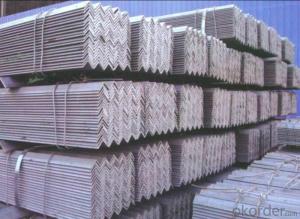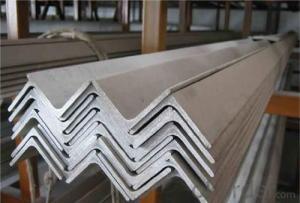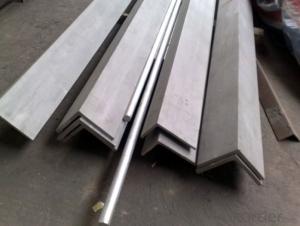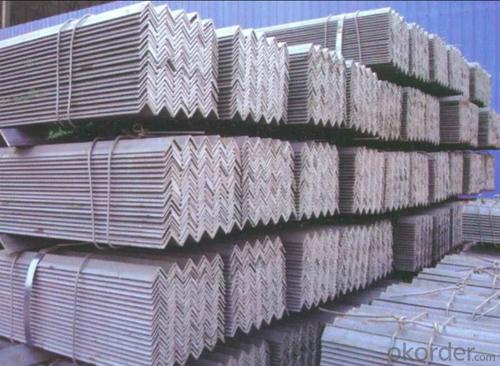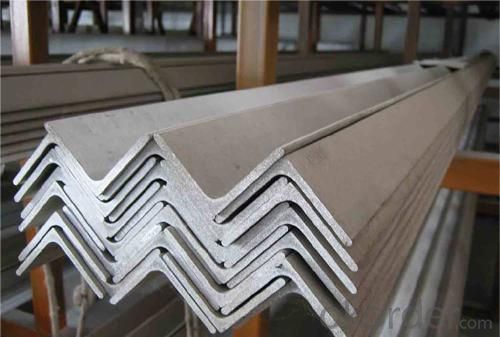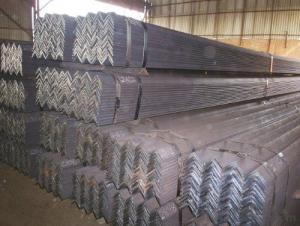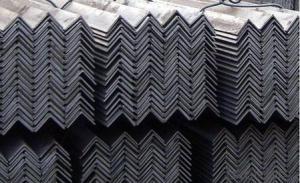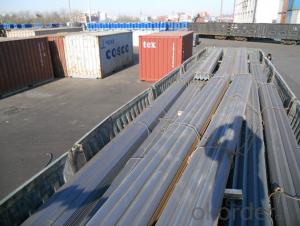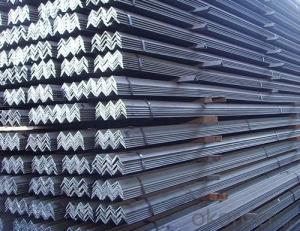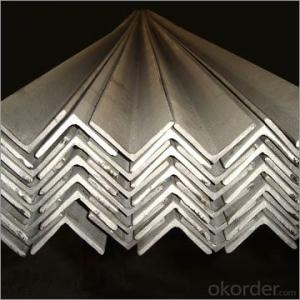Equal steel angle for construction common
- Loading Port:
- Tianjin
- Payment Terms:
- TT or LC
- Min Order Qty:
- 25 m.t.
- Supply Capability:
- 100000 m.t./month
OKorder Service Pledge
OKorder Financial Service
You Might Also Like
Product Description:
OKorder is offering Equal steel angle for construction common at great prices with worldwide shipping. Our supplier is a world-class manufacturer of steel, with our products utilized the world over. OKorder annually supplies products to European, North American and Asian markets. We provide quotations within 24 hours of receiving an inquiry and guarantee competitive prices.
Product Applications:
Equal steel angle are ideal for structural applications and are widely used in the construction of buildings and bridges, and the manufacturing, petrochemical, and transportation industries.
Product Advantages:
OKorder's Steel angle are durable, strong, and resist corrosion.
Main Product Features:
· Premium quality
· Prompt delivery & seaworthy packing (30 days after receiving deposit)
· Corrosion resistance
· Can be recycled and reused
· Mill test certification
· Professional Service
· Competitive pricing
Product Specifications:
Angle Steel Details:
| Minimum Order Quantity: | 25mts | Unit: | m.t. | Loading Port: | China Main Port |
| Supply Ability: | 80000-100000MTS/YEAR | Payment Terms: | TT or LC |
Product Description:
Specifications of JIS SS400 Angle Steel
1.Standards:GB,ASTM,BS,AISI,DIN,JIS
2.Invoicing on theoretical weight or actual weight as customer request
3.Material: JIS G3192,SS400;SS540.
4. Payment terms:
1).100% irrevocable L/C at sight.
2).30% T/T prepaid and the balance against the copy of B/L.
3).30% T/T prepaid and the balance against L/C
5.Sizes:
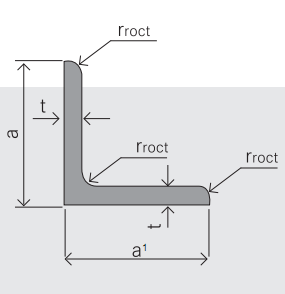
EQUAL ANGLES SIZES |
| ||
a(mm) | a1(mm) | thickness(mm) | length |
25 | 25 | 2.5---3.0 | 6M/12M |
30 | 30 | 2.5---4.0 | 6M/12M |
38 | 38 | 2.5 | 6M/12M |
38 | 38 | 3.0---5.0 | 6M/12M |
40 | 40 | 3.0---6.0 | 6M/12M |
50 | 50 | 3 | 6M/12M |
50 | 50 | 3.7---6.0 | 6M/9M/12M |
60 | 60 | 5.0---6.0 | 6M/9M/12M |
63 | 63 | 6.0---8.0 | 6M/9M/12M |
65 | 65 | 5.0---8.0 | 6M/9M/12M |
70 | 70 | 6.0---7.0 | 6M/9M/12M |
75 | 75 | 5.0---10.0 | 6M/9M/12M |
80 | 80 | 6.0---10.0 | 6M/9M/12M |
90 | 90 | 6.0---10.0 | 6M/9M/12M |
100 | 100 | 6.0---12.0 | 6M/9M/12M |
120 | 120 | 8.0-12.0 | 6M/9M/12M |
125 | 125 | 8.0---12.0 | 6M/9M/12M |
130 | 130 | 9.0-12.0 | 6M/9M/12M |
140 | 140 | 10.0-16.0 | 6M/9M/12M |
150 | 150 | 10---15 | 6M/9M/12M |
160 | 160 | 10---16 | 6M/9M/12M |
180 | 180 | 12---18 | 6M/9M/12M |
200 | 200 | 14---20 | 6M/9M/12M |
5. Material Specifications:
Grade | Yield Strength,N/mm² | Extension Strength N/mm² | |||
Thickness of Steel,mm | |||||
≦16 | >16-≦40 | >40-≦100 | >100 | ||
SS330 | ≧205 | ≧195 | ≧175 | ≧165 | 330-430 |
SS400 | ≧245 | ≧235 | ≧215 | ≧205 | 400-510 |
SS490 | ≧285 | ≧275 | ≧255 | ≧245 | 490-610 |
SS540 | ≧400 | ≧390 | - | - | ≧540 |
Usage & Applications Angle Steel
Trusses;
Transmission towers;
Telecommunication towers;
Bracing for general structures;
Stiffeners in structural use.
Packaging & Delivery of Angle Steel
1. Transportation: the goods are delivered by truck from mill to loading port, the maximum quantity can be loaded is around 40MTs by each truck. If the order quantity cannot reach the full truck loaded, the transportation cost per ton will be little higher than full load.
2. With bundles and load in 20 feet/40 feet container, or by bulk cargo, also we could do as customer's request.
3. Marks:
Color mark: There will be color marking on both end of the bundle for the cargo delivered by bulk vessel. That makes it easily to distinguish at the destination port.
Tag mark: There will be tag mark tied up on the bundles. The information usually including supplier logo and name, product name, made in China, shipping marks and other information request by the customer.
If loading by container the marking is not needed, but we will prepare it as customer request.
Production flow of Angle Steel
Material prepare (billet) —heat up—rough rolling—precision rolling—cooling—packing—storage and transportation
Product Description:
Angle Steel Details:
| Minimum Order Quantity: | 25mts | Unit: | m.t. | Loading Port: | China Main Port |
| Supply Ability: | 80000-100000MTS/YEAR | Payment Terms: | TT or LC |
Product Description:
Specifications of JIS SS400 Angle Steel
1.Standards:GB,ASTM,BS,AISI,DIN,JIS
2.Invoicing on theoretical weight or actual weight as customer request
3.Material: JIS G3192,SS400;SS540.
4. Payment terms:
1).100% irrevocable L/C at sight.
2).30% T/T prepaid and the balance against the copy of B/L.
3).30% T/T prepaid and the balance against L/C
5.Sizes:

EQUAL ANGLES SIZES |
| ||
a(mm) | a1(mm) | thickness(mm) | length |
25 | 25 | 2.5---3.0 | 6M/12M |
30 | 30 | 2.5---4.0 | 6M/12M |
38 | 38 | 2.5 | 6M/12M |
38 | 38 | 3.0---5.0 | 6M/12M |
40 | 40 | 3.0---6.0 | 6M/12M |
50 | 50 | 3 | 6M/12M |
50 | 50 | 3.7---6.0 | 6M/9M/12M |
60 | 60 | 5.0---6.0 | 6M/9M/12M |
63 | 63 | 6.0---8.0 | 6M/9M/12M |
65 | 65 | 5.0---8.0 | 6M/9M/12M |
70 | 70 | 6.0---7.0 | 6M/9M/12M |
75 | 75 | 5.0---10.0 | 6M/9M/12M |
80 | 80 | 6.0---10.0 | 6M/9M/12M |
90 | 90 | 6.0---10.0 | 6M/9M/12M |
100 | 100 | 6.0---12.0 | 6M/9M/12M |
120 | 120 | 8.0-12.0 | 6M/9M/12M |
125 | 125 | 8.0---12.0 | 6M/9M/12M |
130 | 130 | 9.0-12.0 | 6M/9M/12M |
140 | 140 | 10.0-16.0 | 6M/9M/12M |
150 | 150 | 10---15 | 6M/9M/12M |
160 | 160 | 10---16 | 6M/9M/12M |
180 | 180 | 12---18 | 6M/9M/12M |
200 | 200 | 14---20 | 6M/9M/12M |
5. Material Specifications:
Grade | Yield Strength,N/mm² | Extension Strength N/mm² | |||
Thickness of Steel,mm | |||||
≦16 | >16-≦40 | >40-≦100 | >100 | ||
SS330 | ≧205 | ≧195 | ≧175 | ≧165 | 330-430 |
SS400 | ≧245 | ≧235 | ≧215 | ≧205 | 400-510 |
SS490 | ≧285 | ≧275 | ≧255 | ≧245 | 490-610 |
SS540 | ≧400 | ≧390 | - | - | ≧540 |
Usage & Applications Angle Steel
Trusses;
Transmission towers;
Telecommunication towers;
Bracing for general structures;
Stiffeners in structural use.
Packaging & Delivery of Angle Steel
1. Transportation: the goods are delivered by truck from mill to loading port, the maximum quantity can be loaded is around 40MTs by each truck. If the order quantity cannot reach the full truck loaded, the transportation cost per ton will be little higher than full load.
2. With bundles and load in 20 feet/40 feet container, or by bulk cargo, also we could do as customer's request.
3. Marks:
Color mark: There will be color marking on both end of the bundle for the cargo delivered by bulk vessel. That makes it easily to distinguish at the destination port.
Tag mark: There will be tag mark tied up on the bundles. The information usually including supplier logo and name, product name, made in China, shipping marks and other information request by the customer.
If loading by container the marking is not needed, but we will prepare it as customer request.
Production flow of Angle Steel
Material prepare (billet) —heat up—rough rolling—precision rolling—cooling—packing—storage and transportation
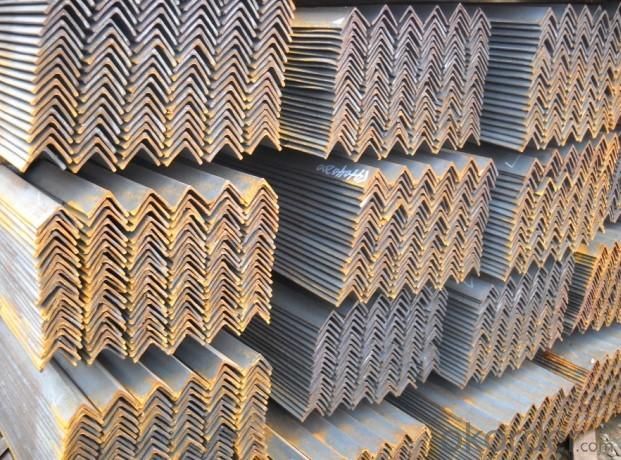
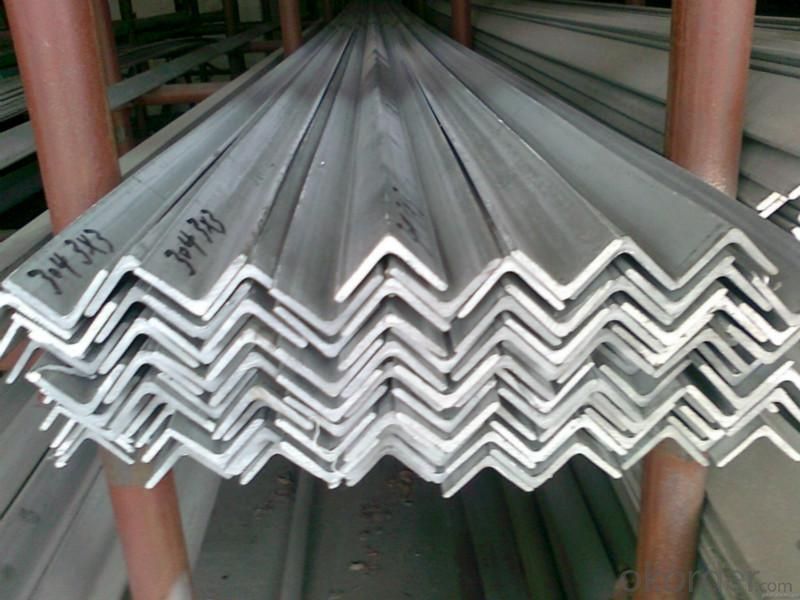
FAQ:
FAQ:
Q1: Why buy Materials & Equipment from OKorder.com?
A1: All products offered byOKorder.com are carefully selected from China's most reliable manufacturing enterprises. Through its ISO certifications, OKorder.com adheres to the highest standards and a commitment to supply chain safety and customer satisfaction.
Q2: How do we guarantee the quality of our products?
A2: We have established an advanced quality management system which conducts strict quality tests at every step, from raw materials to the final product. At the same time, we provide extensive follow-up service assurances as required.
- Q: What are the different grades of steel used for angles?
- The different grades of steel commonly used for angles include A36, A572, and A588.
- Q: Are there any limitations or restrictions on the use of steel angles?
- Indeed, there exist certain limitations and restrictions pertaining to the utilization of steel angles. One of these limitations concerns the maximum load capacity that they can withstand. The load-bearing capacity of steel angles depends on their size, shape, and material composition. Exceeding this capacity can result in structural failure or collapse. Another limitation is associated with the installation and fixing methods of the angles. Typically, steel angles are secured through welding, bolting, or other fastening techniques. The effectiveness and strength of these methods can be influenced by factors like weld quality or the type of fasteners employed. To ensure secure attachment, it is imperative to adhere to proper installation procedures and recommended guidelines. Furthermore, steel angles may face restrictions on their usage in specific environments or applications. For instance, in highly corrosive environments, steel angles may not be suitable unless appropriate protective coatings or materials are utilized. Similarly, in applications where fire resistance is crucial, steel angles may need to be treated with fire-resistant coatings or replaced with fire-resistant materials. Moreover, limitations can arise from the dimensions and lengths of steel angles. Steel angles are available in various sizes and lengths, and careful selection of these dimensions is essential to meet the specific requirements of a project. Factors such as load distribution, span length, and overall structural design must be considered to ensure the suitability of the chosen steel angles for the intended application. To summarize, while steel angles are versatile and widely employed in construction and engineering applications, it is crucial to be aware of their limitations and restrictions. These include load-bearing capacity, installation methods, environmental considerations, and dimensional constraints. Consulting with structural engineers, adhering to industry standards, and implementing proper planning are essential to ensure the safe and effective use of steel angles.
- Q: Can steel angles be used for manufacturing staircases?
- Yes, steel angles can be used for manufacturing staircases. Steel angles are commonly used in construction and fabrication due to their strength, durability, and versatility. When used for staircases, steel angles can provide the necessary support and structural integrity required to ensure the safety and stability of the staircase. They can be used to create the framework, stringers, and risers of the stairs, providing a solid base for the steps. Steel angles can be easily welded, bolted, or otherwise connected to form a sturdy staircase. Additionally, they can be easily customized to fit specific design requirements and can be coated or painted to enhance their aesthetic appeal. Overall, steel angles are a popular choice for manufacturing staircases due to their strength, durability, and adaptability.
- Q: Can steel angles be used for decorative trims?
- Certainly! Decorative trims can indeed utilize steel angles. Steel angles possess versatility, enabling them to be cut, shaped, and fabricated into diverse decorative components. Their application extends to both interior and exterior spaces, imparting a contemporary and industrial flair. By employing paint or powder coating, steel angles can be adorned in an extensive array of colors to suit any desired aesthetic. Utilize them as decorative trims encircling windows, doors, cabinets, furniture, or even as accent pieces adorning walls or ceilings. Due to their enduring durability and strength, steel angles emerge as a long-lasting and low-maintenance choice for decorative trims.
- Q: How do steel angles provide structural support?
- Steel angles provide structural support by distributing and transferring loads and forces in various structures. They are commonly used as braces or brackets to reinforce and stabilize beams, columns, and other members. The L-shaped design of steel angles allows them to resist bending and provide strength and rigidity to the structure. They can be bolted or welded to the main structural components, thereby increasing their load-carrying capacity and overall stability.
- Q: What are the different packaging options for steel angles?
- There are several packaging options available for steel angles, depending on the specific needs and requirements of the customer and the mode of transportation. Some of the common packaging options include: 1. Bundles: Steel angles are often packaged in bundles, which are created by tying together multiple pieces of angles using steel straps or wires. This packaging option is commonly used for larger quantities and provides stability and ease of handling. 2. Pallets: Steel angles can also be packaged on pallets, which are wooden or plastic platforms used for easy transportation and storage. The angles are typically stacked on top of each other and secured to the pallet using straps or stretch wrap. 3. Crates: For added protection, steel angles can be packaged in wooden crates. Crates provide a sturdy and secure packaging option, especially for long-distance transportation or when the angles need to be stored in outdoor conditions. 4. Steel Cages: In some cases, steel angles are packaged in steel cages, which are metal structures with open sides that allow for easy visibility and ventilation. This packaging option is often used when the angles need to be stored or transported in bulk quantities. 5. Customized Packaging: Depending on the specific requirements of the customer, steel angles can also be packaged in customized ways. This may include adding protective materials such as foam or plastic sheets to prevent scratches or damage during transit. It is important to note that the choice of packaging option may depend on factors such as the size and weight of the steel angles, the mode of transportation (road, rail, sea, air), and any specific regulations or guidelines that need to be followed.
- Q: Can steel angles be used to create decorative elements in architecture?
- Yes, steel angles can definitely be used to create decorative elements in architecture. Steel angles, also known as angle irons, are versatile and can be easily manipulated to create various shapes and designs. They can be cut, bent, and welded to form intricate patterns, ornamental details, and decorative accents. Steel angles can be used in various architectural applications, such as railings, balusters, window grilles, door frames, brackets, and ornamental trims. Their strength and durability make them suitable for both indoor and outdoor use. They can be finished with different coatings, such as paint or powder coating, to enhance their appearance and protect them from corrosion. Architects and designers often incorporate steel angles in modern and contemporary designs to add an industrial, sleek, and minimalist touch. The clean lines and geometric shapes of steel angles can provide a modern aesthetic to buildings and structures. They can be used to create unique and eye-catching patterns, adding visual interest and a sense of style to architectural projects. Moreover, steel angles can also be combined with other materials, such as glass, wood, or stone, to create a striking contrast and achieve a harmonious blend of materials. This versatility allows for endless design possibilities, enabling architects to create truly customized and distinctive decorative elements. In conclusion, steel angles can be effectively used to create decorative elements in architecture. Their versatility, strength, and potential for customization make them an ideal choice for architects and designers looking to add aesthetic appeal and uniqueness to their projects.
- Q: What are the disadvantages of using steel angles?
- There are several disadvantages of using steel angles in various applications. One of the main disadvantages is their susceptibility to corrosion. Steel angles are typically made from carbon steel, which is prone to rusting when exposed to moisture and harsh environmental conditions. This can lead to structural weakening and reduced durability over time. Another disadvantage is their weight and bulkiness. Steel angles are often heavy and bulky, making them difficult to handle and transport. This can increase the overall cost of the project, as special equipment or additional labor may be required for installation. Steel angles also have limited flexibility and versatility in terms of design. They are typically available in standard sizes and shapes, which can restrict their use in certain applications that require custom or intricate designs. This lack of flexibility may result in additional costs for fabrication or the need for alternative materials. Additionally, steel angles can be more expensive compared to other materials such as aluminum or wood. This can make them less cost-effective in certain projects, especially in situations where the structural requirements can be met with alternative materials that are more affordable. Lastly, steel angles can conduct heat and electricity, which may not be desirable in certain applications. This can pose safety risks in electrical or heat-sensitive environments, requiring additional insulation or protective measures. Overall, while steel angles offer several advantages such as high strength and durability, their disadvantages include susceptibility to corrosion, weight and bulkiness, limited flexibility in design, higher cost, and conductivity of heat and electricity. These factors should be carefully considered when deciding whether to use steel angles in a particular project.
- Q: What is the typical thickness tolerance for steel angles?
- The typical thickness tolerance for steel angles is typically around ±1/16 inch or ±1.59 mm.
- Q: What is the minimum radius for a curved steel angle?
- Various factors, such as the thickness and width of the steel angle, as well as the desired degree of curvature, influence the minimum radius required for a curved steel angle. Typically, the minimum radius is determined based on the material's bending capability, ensuring that no permanent deformation or cracking occurs. To ascertain the precise minimum radius for a particular curved steel angle, it is crucial to refer to the manufacturer's instructions or seek the advice of a structural steel engineer.
Send your message to us
Equal steel angle for construction common
- Loading Port:
- Tianjin
- Payment Terms:
- TT or LC
- Min Order Qty:
- 25 m.t.
- Supply Capability:
- 100000 m.t./month
OKorder Service Pledge
OKorder Financial Service
Similar products
Hot products
Hot Searches
Related keywords
